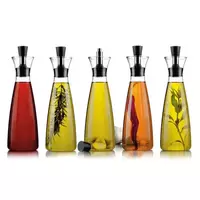Vinegar

Both culinary professionals and modern hostesses often use such a popular product around the world as vinegar in the process of preparing various dishes. At its core, vinegar is a product that contains a large amount of acetic acid in its chemical composition. Traditional vinegar is obtained by microbiological synthesis, which occurs in alcohol-containing raw materials.
Vinegar composition
There are two main types of vinegar - natural and synthetic. Natural vinegar may contain citric, malic, succinic, tartaric and other acids, as well as esters, alcohols and aldehydes. All of the above substances included in the vinegar give the product an original taste, aroma, as well as consumer characteristics.
For many millennia of the product's existence, people have perfectly mastered the art of using the distinctive taste properties of vinegar in the process of making various culinary products. Vinegar, as a rule, includes an alcohol-containing component, as well as grape, apple or fruit juice. In addition, wine materials are used to produce vinegar, which undergo a natural fermentation process.
Types of vinegar
Among the main and most commonly used types of vinegar in cooking, the following can be distinguished:
alcohol vinegar;
rice vinegar;
apple cider vinegar or fruit vinegar;
wine vinegar;
alcoholic flavored vinegar, for example with extracts of fragrance, tarragon, garlic, pepper, etc. ;
balsamic vinegar;
whey vinegar;
malt vinegar;
sherry vinegar;
synthetic vinegar
The properties of vinegar are due to the chemical composition of the product. Vinegar is used as an independent seasoning or component in the process of preparing sauces, marinades, as well as salad dressings. Often vinegar is used to prepare drinks. It is worth noting that in addition to cooking, vinegar is used for medical purposes.
Vinegar benefits
It is believed that the benefits of vinegar can be used for preventive and medicinal purposes in some diseases. The unique benefits of vinegar are widely used in pharmacological production. In addition, vinegar is used for the production of disinfectants. The calorie content of vinegar depends primarily on the type of product. However, the average calorie content of vinegar is at 1
1. 3 Kcal, which are per 100 grams of product.
Vinegar harm
In addition to invaluable benefits, you can get harm from vinegar. In fairness, it is worth noting that the harm of vinegar can only be obtained if a large amount of the product is regularly eaten. Due to the high content of natural acids, vinegar can cause significant harm to people suffering from some diseases of the gastrointestinal tract.
Doctors recommend excluding vinegar from the diet for patients with gastritis, hepatitis, and pancreatitis. In addition, you should not eat vinegar for stomach and intestinal ulcers, as well as for enteritis and cholecystitis.
vinegar 11.3 kCal
Energy value of vinegar (Ratio of proteins, fats, carbohydrates - ju):
Proteins: 0 g (~ 0 kCal)
Fats: 0 g (~ 0 kCal)
Carbohydrates: 3g (~ 12kCal)
Energy ratio (bj | y): 0% | 0% | 106%
 Español
Español Français
Français Português
Português Русский
Русский 简体中文
简体中文 繁體中文
繁體中文 日本語
日本語 한국어
한국어 العربية
العربية Türkçe
Türkçe Қазақ
Қазақ Deutsch
Deutsch Italiano
Italiano Українська
Українська
